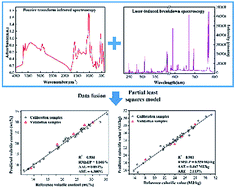Combining laser-induced breakdown spectroscopy and Fourier-transform infrared spectroscopy for the analysis of coal properties
Abstract
Coal properties are associated with both elements and molecular structure. In this study, to improve the analysis performance of coal properties (e.g. the volatile content and calorific value), a data fusion scheme for combining laser-induced breakdown spectroscopy (LIBS) and Fourier-transform infrared spectroscopy (FTIR) was proposed in order to simultaneously extract elemental and molecular information. Ward's minimum variance method was applied to classify coal samples and determine the calibration set and the validation set prior to establishing the calibration model. A partial least-squares (PLS) model was employed to analyze the volatile content and calorific value using the second derivative FTIR spectrum (2ndDev-FTIR), LIBS, and a combination of LIBS and the second derivative FTIR spectrum (LIBS&2ndDev-FTIR), respectively. The analysis results of these three schemes were compared. The root mean square error of prediction (RMSEP) of the volatile content was decreased from 2.937% (2ndDev-FTIR) and 1.622% (LIBS) to 0.884% (LIBS&2ndDev-FTIR), and the RMSEP of the calorific value was also decreased from 1.095 MJ kg−1 (2ndDev-FTIR) and 0.613 MJ kg−1 (LIBS) to 0.559 MJ kg−1 (LIBS&2ndDev-FTIR). Similarly, the same trend was indicated in the average absolute error (AAE) and the average relative error (ARE). The improvement in the predictive performance can be attributed to the synergy between the elemental information obtained from LIBS and the molecular information gained from FTIR spectroscopy. The results demonstrated the feasibility of combining LIBS and FTIR spectroscopy to provide an improved analytical result for the volatile content and calorific value of coal.



 Please wait while we load your content...
Please wait while we load your content...